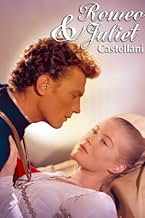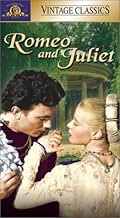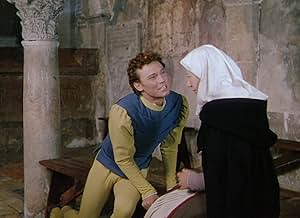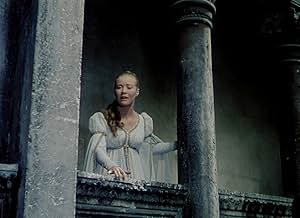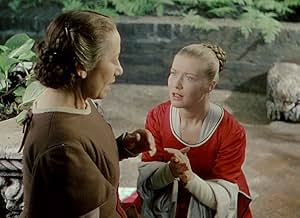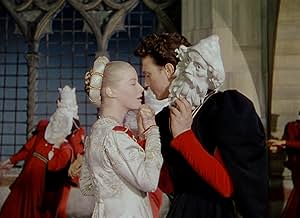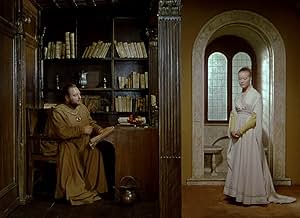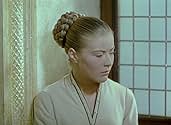IMDb RATING
6.0/10
677
YOUR RATING
In Shakespeare's classic play, the Montagues and Capulets, two families of Renaissance Italy, have hated each other for years, but the son of one family and the daughter of the other fall de... Read allIn Shakespeare's classic play, the Montagues and Capulets, two families of Renaissance Italy, have hated each other for years, but the son of one family and the daughter of the other fall desperately in love and secretly marry.In Shakespeare's classic play, the Montagues and Capulets, two families of Renaissance Italy, have hated each other for years, but the son of one family and the daughter of the other fall desperately in love and secretly marry.
- Director
- Writers
- Stars
- Nominated for 3 BAFTA Awards
- 6 wins & 6 nominations total
Ennio Flaiano
- Prince of Verona
- (as Giovanni Rota)
Thomas Nicholls
- Brother Giovanni
- (as Tom Nicholls)
- Director
- Writers
- All cast & crew
- Production, box office & more at IMDbPro
Featured reviews
Renato Castellani's ROMEO AND JULIET has somehow fallen into a hole in film history. Despite a handsome production with some worthy performances, it is overshadowed by Franco Zefferelli's 1966 film and even the 1936 MGM movie with Norma Shearer, Leslie Howard, Basil Rathbone, and John Barrymore. One has to wonder why - it was the first version of the movie to be shot (or partially shot) on locale in Italy in color. While the leads are not the proper juveniles that appeared in the 1966 version, Lawrence Harvey and Susan Shentell were closer to the ages of the characters than Howard and Shearer were.
My guess is that it's very reliance on Italian movie production may have been a drawback to the audiences who (unfortunately) counted the most: English - speaking ones. The leads were all English and the basic play (despite the Italian setting) was in English by the greatest writer of the English language. If it had been filmed in England I suspect it would have had more acceptance. But this is a guess. There could have been other factors: bad timing due to more overpowering productions. Orson Welles' had completed and released OTHELLO in 1952 (where it, like this ROMEO AND JULIET, won a prize at the Venice Film Festival). The following year Lawrence Olivier's masterly RICHARD III was released. The failure of the Castellani movie remains striking and puzzling.
Today Zefferelli's version is considered the best one by most viewers, because of his making his hero and heroine what they are: growing teenagers. But one should not sneer at Harvey's attempts at Romeo opposite Shentell's Juliet. They do generate a soft glow between them that gradually picks up heat. I might add that I found Shentell's final suicide rather stark and complete as it should be. Whether due to her acting or the director's direction she gave Juliet's passing a type of dignity I have rarely seen.
As for the performers in the cast, Sebastian Cabot's Capulet is the picture of an Italian Renaissance merchant prince type, corpulent and ruthless towards his family's foes. It's funny thinking of Cabot today as a villain in his roles, but in fact (prior to his going into CHECKMATE on television - where he was the wise spy master of the heroes) most of his film parts were villainous, or (as in THE TIME MACHINE) ridiculously self-important. His belated affability appeared only when he lucked out and became "Mr. French" in FAMILY AFFAIR. So here, a 1954 audience in the know, would have had no problem about his rattlesnake - eyed timing in planning the demise of Montagues. Look at his scene at the ball he is throwing when Tybalt (Enzo Fiormonte) wants to kill Romeo, but Cabot restrains him - adding that it can be done later.
Also note Mervyn Johns as Friar Lawrence, who manages to show the all-to-human side of the good man, which enables so many bad things to occur because of his trusting the wrong people (one messenger is locked up because he is stuck in a quarantined house), or his instructions were not clear enough. Johns was a gifted actor in his own way. Most people remember him as gentle, loving Bob Crachit opposite crusty, nasty Scrooge (Alistair Sim). But he was also the bedeviled and doomed architect in DEAD OF NIGHT, and the equally doomed partner of the ruthless Spencer Tracy in EDWARD MY SON. Johns was a fine character role player, and was lucky to pass on his skills to his daughter Glynnis.
My guess is that it's very reliance on Italian movie production may have been a drawback to the audiences who (unfortunately) counted the most: English - speaking ones. The leads were all English and the basic play (despite the Italian setting) was in English by the greatest writer of the English language. If it had been filmed in England I suspect it would have had more acceptance. But this is a guess. There could have been other factors: bad timing due to more overpowering productions. Orson Welles' had completed and released OTHELLO in 1952 (where it, like this ROMEO AND JULIET, won a prize at the Venice Film Festival). The following year Lawrence Olivier's masterly RICHARD III was released. The failure of the Castellani movie remains striking and puzzling.
Today Zefferelli's version is considered the best one by most viewers, because of his making his hero and heroine what they are: growing teenagers. But one should not sneer at Harvey's attempts at Romeo opposite Shentell's Juliet. They do generate a soft glow between them that gradually picks up heat. I might add that I found Shentell's final suicide rather stark and complete as it should be. Whether due to her acting or the director's direction she gave Juliet's passing a type of dignity I have rarely seen.
As for the performers in the cast, Sebastian Cabot's Capulet is the picture of an Italian Renaissance merchant prince type, corpulent and ruthless towards his family's foes. It's funny thinking of Cabot today as a villain in his roles, but in fact (prior to his going into CHECKMATE on television - where he was the wise spy master of the heroes) most of his film parts were villainous, or (as in THE TIME MACHINE) ridiculously self-important. His belated affability appeared only when he lucked out and became "Mr. French" in FAMILY AFFAIR. So here, a 1954 audience in the know, would have had no problem about his rattlesnake - eyed timing in planning the demise of Montagues. Look at his scene at the ball he is throwing when Tybalt (Enzo Fiormonte) wants to kill Romeo, but Cabot restrains him - adding that it can be done later.
Also note Mervyn Johns as Friar Lawrence, who manages to show the all-to-human side of the good man, which enables so many bad things to occur because of his trusting the wrong people (one messenger is locked up because he is stuck in a quarantined house), or his instructions were not clear enough. Johns was a gifted actor in his own way. Most people remember him as gentle, loving Bob Crachit opposite crusty, nasty Scrooge (Alistair Sim). But he was also the bedeviled and doomed architect in DEAD OF NIGHT, and the equally doomed partner of the ruthless Spencer Tracy in EDWARD MY SON. Johns was a fine character role player, and was lucky to pass on his skills to his daughter Glynnis.
Of the several different cinematic adaptations of ROMEO & JULIET that are out there, this version has always been my personal favorite since I first saw it in the early 1970s. The Franco Zefferelli production has that distinction but if you've never seen this one, then you should definitely give it a try now that VCI has given us such a gorgeous looking anamorphic transfer. For years I have had the old MGM VHS tape which I will now gladly donate to the local thrift store where there are still customers who use VHS. There's no need to go into the story since everyone knows that, so I'll focus on what it is about this particular adaptation that I enjoy so much.
First are the locations. The film was shot on location in Verona and other Italian cities in such a way as to resemble Renaissance paintings thanks to the skill of legendary cinematographer Robert Krasker (THE THIRD MAN) who shows here that he can use color the way he used black and white in that classic film. Second is the score by Roman Vlad which is written in the style of music of the period. A galliard which serves as a motif throughout the movie is memorable and effective. Last but not least are the performances. Laurence Harvey, 26 at the time, gives the best line readings of any screen Romeo I have ever heard. Some find his Romeo too effiminate but that will always be a matter of personal opinion. Susan Shentall is not the ideal Juliet but she is more than adequate and her death scene manages to be quite moving. Add character players Flora Robson, Bill Travers, Mervyn Johns and Sebastian Cabot to the mix and their characters spring to life.
Italian director Renato Castellani creates an ideal balance in his movie with a theatrical staging that flows cinematically. The style of dialogue delivery is old school Shakespeare which will seem overly mannered to today's younger ears but you can understand every word and, after all, it is a play. My one complaint is that the English subtitles (handy in Shakespeare) are out of sync after the first 30 minutes appearing a few seconds before the characters speak their lines and then disappearing too quickly. Nevertheless it is great to finally have this R & J on DVD and Blu-Ray where it will now reach a new audience who can see it for themselves and make their own comparisons with other versions. This release is part of a series from VCI of classic Rank Organisation films and about time too!..For more reviews visit The Capsule Critic.
First are the locations. The film was shot on location in Verona and other Italian cities in such a way as to resemble Renaissance paintings thanks to the skill of legendary cinematographer Robert Krasker (THE THIRD MAN) who shows here that he can use color the way he used black and white in that classic film. Second is the score by Roman Vlad which is written in the style of music of the period. A galliard which serves as a motif throughout the movie is memorable and effective. Last but not least are the performances. Laurence Harvey, 26 at the time, gives the best line readings of any screen Romeo I have ever heard. Some find his Romeo too effiminate but that will always be a matter of personal opinion. Susan Shentall is not the ideal Juliet but she is more than adequate and her death scene manages to be quite moving. Add character players Flora Robson, Bill Travers, Mervyn Johns and Sebastian Cabot to the mix and their characters spring to life.
Italian director Renato Castellani creates an ideal balance in his movie with a theatrical staging that flows cinematically. The style of dialogue delivery is old school Shakespeare which will seem overly mannered to today's younger ears but you can understand every word and, after all, it is a play. My one complaint is that the English subtitles (handy in Shakespeare) are out of sync after the first 30 minutes appearing a few seconds before the characters speak their lines and then disappearing too quickly. Nevertheless it is great to finally have this R & J on DVD and Blu-Ray where it will now reach a new audience who can see it for themselves and make their own comparisons with other versions. This release is part of a series from VCI of classic Rank Organisation films and about time too!..For more reviews visit The Capsule Critic.
There are certain indispensable elements for a great Romeo and Juliet: youthful, energetic lovers; a brilliant Mercutio and irrepressible Nurse; and crisp pacing. Castellani's version fails on all counts. Take pacing. This is a tragedy of timing; the story unfolds over 4 days of desperate urgency. Yet Castellani's screenplay DRRRAAGGSS, interrupting key scenes with tedious stage business. Take the opening brawl: instead of escalating rapidly, it *stops* while the Capulets lug home the body of a servant, women wail, etc. Who cares about the servant? When do we get to the real action? Similarly, when Romeo opens the tomb, Castellani has him stop, walk all the way back outside, find an appropriate tool, and then start over. What a waste of screen time! It's dismaying that these unnecessary scenes are added at the expense of some of the play's best material. A high point in most productions is Mercutio's Queen Mab speech yet Castellani omits it! All directors make cuts, but why this key speech? Castellani seems to think little of Shakespeare's language, preferring his own dialogue. That's right; he cuts Queen Mab but adds vapid filler for Rosaline and other minor characters. Did he really think no one would notice? As for the actors, Susan Shentall sleep-walks through most of her scenes, but after two hours of Lawrence Harvey's plodding monotone, I can't blame her. These actors can't even summon the energy for a proper swordfight; Tybalt merely stabs Mercutio, while a bored looking Romeo bashes Paris over the head. Where's Basil Rathbone when you need him?
This production is often praised for its lush costumes, picturesque Italian locations and cinematography reminiscent of Italian paintings. It's pretty as a picture, but equally lifeless.
This production is often praised for its lush costumes, picturesque Italian locations and cinematography reminiscent of Italian paintings. It's pretty as a picture, but equally lifeless.
Handsome, leisurely-paced, ineptly cut, often badly acted (especially by Laurence Harvey as Romeo, surprisingly) version of Shakespeare's most playful and youthful tragedy. Much of the film's charm lies in the creation of sumptuous tableaux in the tradition of Italian Renaissance painting, and the portrayal of Capulet is a marvelously acted stereotype of the fat, crude nouveau riche Italian patriarch; but Harvey (despite a few promising moments early on) is far too effusive and unctuous, creepily reminiscent of John Dall in Rope; Susan Shentall displays admirable coyness and gusto in the "overture" of the dance and courtship scenes, but stiffens and is stifled by the death of a thousand cuts toward the end (although almost nothing is cut from the first act). Still, aside from some ghastly, somnambulistic line readings, the film often dazzles with its feeling for the music of Shakespeare's text; the Nurse's folkloric shanty is highlighted with musical settings (shadings)-- Flora Robson is delightful in the role; the vaguely rappish banter of Benvolio and Romeo's first scene is gracefully and intelligently played. The presentation of the episode of losing the letter due to the Plague is a brilliant use of cinema to bring out embedded narrative in Shakespeare. The near-interchangeability of the actors who play Benvolio, Tybalt and Paris is regrettable.
Yes, this film has been overpraised by Pauline Kael and others. For its time it was revolutionary, because no previous Shakespeare film had used so many outdoor, realistic locations. Unlike the previous MGM version (which all in all is superior), this version did not use middle-aged actors and made splendid use of technicolor. Black and white cinematography may suit MACBETH, HAMLET, KING LEAR, and other Shakespeare trajedies--but not this one. Since 1954, however, it has been remade in more cinematic and dynamic versions.
Nonetheless, it's a very worthwhile movie, especially for Shakespeare fans. I personally think Laurence Harvey is a terrific Romeo. Yes, he's a bit of a simp, but that's the character. In fact, Harvey is the screen's best Romeo; he's a lot more passionate than Leslie Howard in the MGM version, and he speaks the verse better than either DiCaprio or Leonard Whitting in the two subsequent versions. The locations, better than any version, remind us of just how thin the streets were in Verona during the time of the play, and the high, thick, stone walls serve as a symbol of the intransigence of the families.
Yes, it does have shortcomings, but don't dismiss its virtues, which are many, especially to those of us who want more than the MTV-type Shakespeare that the DiCaprio version offers.
Nonetheless, it's a very worthwhile movie, especially for Shakespeare fans. I personally think Laurence Harvey is a terrific Romeo. Yes, he's a bit of a simp, but that's the character. In fact, Harvey is the screen's best Romeo; he's a lot more passionate than Leslie Howard in the MGM version, and he speaks the verse better than either DiCaprio or Leonard Whitting in the two subsequent versions. The locations, better than any version, remind us of just how thin the streets were in Verona during the time of the play, and the high, thick, stone walls serve as a symbol of the intransigence of the families.
Yes, it does have shortcomings, but don't dismiss its virtues, which are many, especially to those of us who want more than the MTV-type Shakespeare that the DiCaprio version offers.
Did you know
- TriviaDame Joan Collins was originally slated to play Juliet, but turned it down when Writer and Director Renato Castellani insisted she undergo surgery to change the shape of her nose.
- ConnectionsReferenced in Arena: All the World's a Screen - Shakespeare on Film (2016)
- How long is Romeo and Juliet?Powered by Alexa
Details
- Release date
- Countries of origin
- Official site
- Languages
- Also known as
- Romeo and Juliet
- Filming locations
- Italy(made in Italy)
- Production companies
- See more company credits at IMDbPro
- Runtime2 hours 21 minutes
Contribute to this page
Suggest an edit or add missing content


